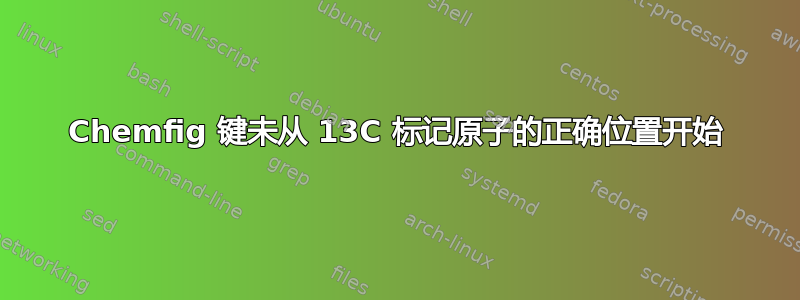
我试图引起以下反应
但正如您所看到的,单键不是从碳 13 标记原子 (^{13}C) 的右下角开始,而是从该原子下方的某个位置开始。如果我删除下标“13”,定位是正确的,但在这个特定的反应中,选择性碳 13 标记很重要。
有人知道如何实现这一点吗?我尝试过 \lbox 和类似的东西,但行为总是一样的...
梅威瑟:
\documentclass{article}
\usepackage{chemfig,chemmacros}
\begin{document}
\begin{equation}
\begin{split}
\schemestart
\setatomsep{2em}\chemfig*{^{-}OO{\color{blue}^{13}C}-[::-30,,3]=[::60]-[::-60]{\color{blue}^{13}C}OO^{-}} \arrow{0}[,0] \+ \chemfig*{H_2O}
\arrow{<=>[\footnotesize fumarase]}[,1.3]
\setatomsep{2em}\chemfig*{^{-}OO{\color{blue}^{13}C}-[::-30]-[::60](<:[::60]OH)-[::-60]{\color{blue}^{13}C}OO^{-}}
\schemestop
\end{split}
\end{equation}
\end{document}
感谢您对如何解决该问题提出任何建议。
答案1
不需要\quad或任何其他长度。你只需要说出chemfig正确的东西。技巧可以在手册第三部分(高级用法)第 1 节(分离原子)中找到:
字符“
|”在遇到原子时强制分裂原子。因此,我们可以写出C|{(CH_3)_3}以确保 ChemFig 只分隔两个原子:“C”和“{(CH_3)_3}”。
对于你的情况这意味着而不是写在{\color{blue}^{13}C}-[::-30,,3]哪里{\color{blue}^{13}C}一原子写入\color{blue}^{13}|{\color{blue}C}-[::-30,,4]:
\documentclass{article}
\usepackage{chemfig}
\begin{document}
\begin{center}
\setatomsep{2em}
\schemestart
\chemfig*{
^{-}OO\color{blue}^{13}|{\color{blue}C}
-[::-30,,4]=[::60]-[::-60]
\color{blue}^{13}|{\color{blue}C}OO^{-}}
\arrow{0}[,0]
\+ \chemfig*{H_2O}
\arrow{<=>[\footnotesize fumarase]}[,1.3]
\chemfig*{
^{-}OO\color{blue}^{13}|{\color{blue}C}
-[::-30]-[::60](<:[::60]OH)-[::-60]
\color{blue}^{13}|{\color{blue}C}OO^{-}
}
\schemestop
\end{center}
\end{document}
顺便说一句:将化学方案放在 的split环境内是相当奇怪的equation。我使用了center,这对我来说似乎更自然。也许你想要方程编号。但是 an 就equation足够了:
\documentclass{article}
\usepackage[margin=1in]{geometry}
\usepackage{chemfig}
\begin{document}
\begin{equation}
\setatomsep{2em}
\schemestart
\chemfig*{
^{-}OO\color{blue}^{13}|{\color{blue}C}
-[::-30,,4]=[::60]-[::-60]
\color{blue}^{13}|{\color{blue}C}OO^{-}}
\arrow{0}[,0]
\+ \chemfig*{H_2O}
\arrow{<=>[\footnotesize fumarase]}[,1.3]
\chemfig*{
^{-}OO\color{blue}^{13}|{\color{blue}C}
-[::-30]-[::60](<:[::60]OH)-[::-60]
\color{blue}^{13}|{\color{blue}C}OO^{-}
}
\schemestop
\end{equation}
\end{document}
答案2
嗯,首先,你发布的 MWE 无法编译因为你忘了把它包起来 \begin{document}...\end{document}。关于您的问题;这非常容易解决。您所要做的就是用一些额外的空间“诱使”键的位置。在这种情况下,我使用了\quad,但您也可以使用更少和更多的负(\!)或正(\,,\;等\.)空间,以便图片符合您的需要。不过有一点需要注意 - 我的原件(1)放错了位置,因为我的边距太小,无法容纳您的的长度chemfig。我相信您可以自己解决这个细节(毕竟这是您的 LaTeX 编译器、计算机和设置)。因为我不想让文档看起来丑陋,所以我用扩展了页面宽度\textwidth。无论如何,代码。
\documentclass{article}
\usepackage{chemfig,chemmacros}
\textwidth = 400pt
\begin{document}
\begin{equation}
\begin{split}
\schemestart
\setatomsep{2em}\chemfig*{^{-}OO{\color{blue}^{13}C \quad}-[::-30,,3]=[::60]-[::-60]{\color{blue}^{13}C}OO^{-}} \arrow{0}[,0] \+ \chemfig*{H_2O}
\arrow{<=>[\footnotesize fumarase]}[,1.3]
\setatomsep{2em}\chemfig*{^{-}OO{\color{blue}^{13}C \quad}-[::-30]-[::60](<:[::60]OH)-[::-60]{\color{blue}^{13}C}OO^{-}}
\schemestop
\end{split}
\end{equation}
\end{document}
结果如下。





